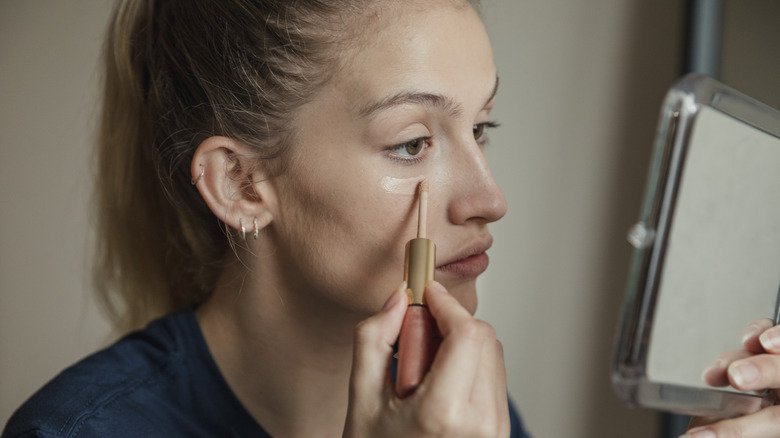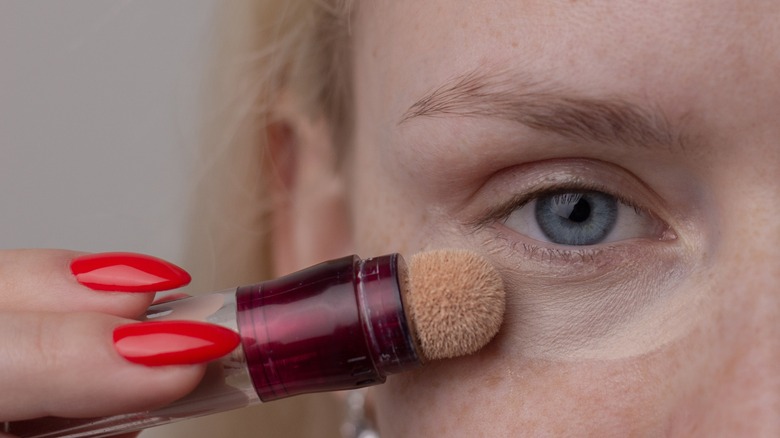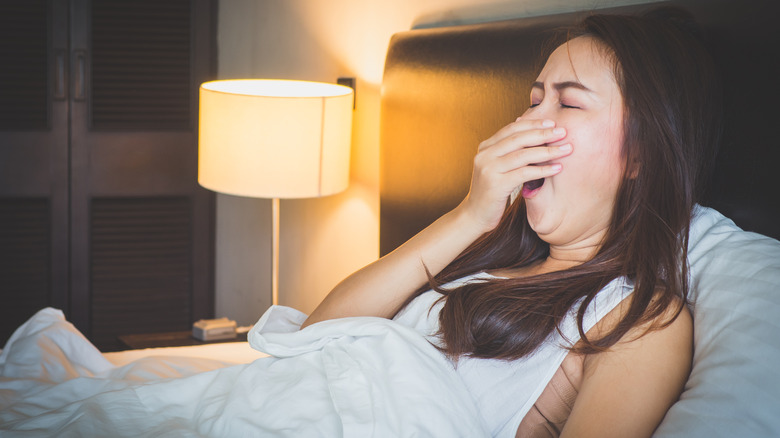The Importance Of Picking A Neutralizing Concealer Shade For Dark Under-Eyes
Some are more prone than others to developing dark circles under their eyes after an all-nighter, but plenty of people are predisposed to this unsightly issue. Everything from genetics to medical conditions, such as eczema, can result in dark circles that may make you look more fatigued than you actually feel. Luckily, there's makeup for this sort of problem, and knowing how to use it appropriately can hide dark circles in minutes.
Concealer is an obvious choice for covering everything from blemishes to under-eye bags, but the color you select can make all the difference. Makeup artist Kay Montano explained to Net-a-Porter that it's essential to choose a hue that can neutralize shadows, rather than match your natural skin tone. "You want a shade that will neutralize the blue or gray shadows that can appear under the eyes," Montano said. "For pale skin, that means a concealer that is peachier than your natural complexion; for Black skin, choose a concealer with terracotta undertones to neutralize the gray that can appear under eyes."
Familiarizing yourself with the benefits of different concealer tints can help you with more than just dark under-eye circles (think blemishes, too). Additionally, you can do more than just cover up these circles with cosmetics to minimize their appearance. Trying multiple tips may be the approach you'll want to take if they're a recurring problem for you.
Understanding the different tints of neutralizing concealers
As you begin to explore the potential of using concealer to cover your dark under-eye circles, you may come across products marketed as "correctors." Don't be thrown off by this word — it simply means the concealer or foundation is tinted to "correct" discoloration as a result of under-eye circles, for example.
When it comes to using these products, there are a few rules of thumb. Yellow-based correctors are best on beige skin if you're trying to neutralize blue or green undertones, while lilac correctors are better for evening out your skin tone if it has hints of yellow. If you have a browner skin tone and you want to mask blue or gray undertones, an orange corrector will be most effective. A color wheel can help if you're still confused while shopping for a corrector.
When it comes time to apply the concealer under your eyes, make sure your skin is as hydrated as possible — you may even want to apply an eye cream beforehand. By doing so, you can avoid creating a dull appearance and nail the brighter, perkier look you're trying to achieve. Using a fluffy brush, apply the corrector under your eyes, making sure to only use it on the darkened areas of your skin. Finish it off with a concealer that closely resembles your natural skin tone.
Going beyond concealer to prevent dark under-eye circles
Once you begin experimenting with neutralizing concealers, there are a few tips you can keep in mind to ensure your skin always looks flawless. For instance, it's important to remember that these color-correcting cosmetics are not meant to be finishing touches. "Color corrector should be used before concealers, so that they look more natural when blended into the base makeup," makeup artist Shara Strand told Reader's Digest. It's also critical to blend and highlight after application to give your skin an even, seamless appearance.
If dark under-eye circles are a frequent problem for you, don't just turn to your makeup as a solution — there may be underlying causes contributing to the issue. For example, a lack of sleep can result in pale skin under your eyes, making your blood vessels more visible. Similarly, dehydration can impact the skin in this area and result in the same problem. It might be worth taking lifestyle factors into account as well, such as smoking, stress, and alcohol consumption — all of which can contribute to dark under-eye circles.
These circles can be indicative of a medical issue, however, if you notice additional symptoms, such as swelling under your eyes. Don't hesitate to contact your doctor if you have any concerns or recognize unusual changes in your eyes' appearance. Medical treatment may be necessary if they detect an underlying condition.


